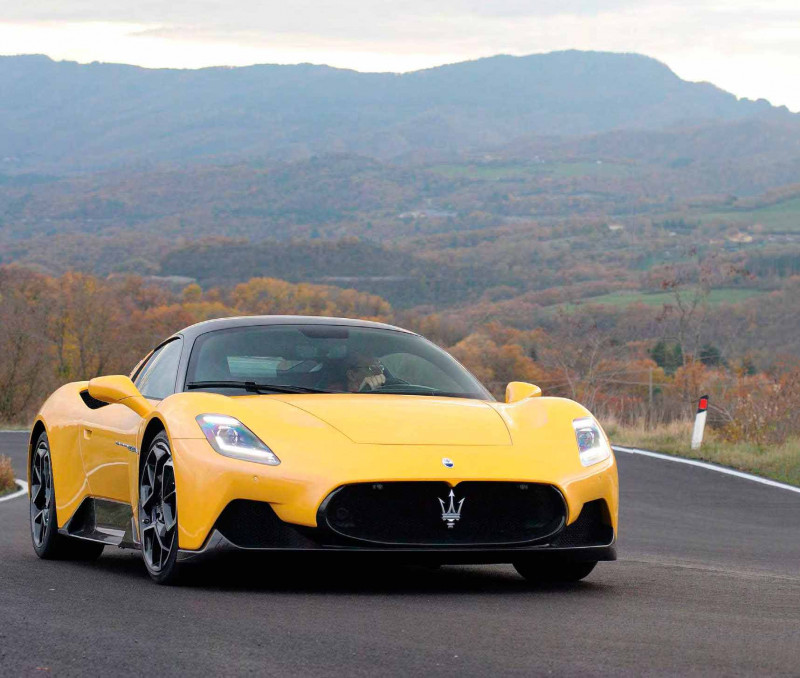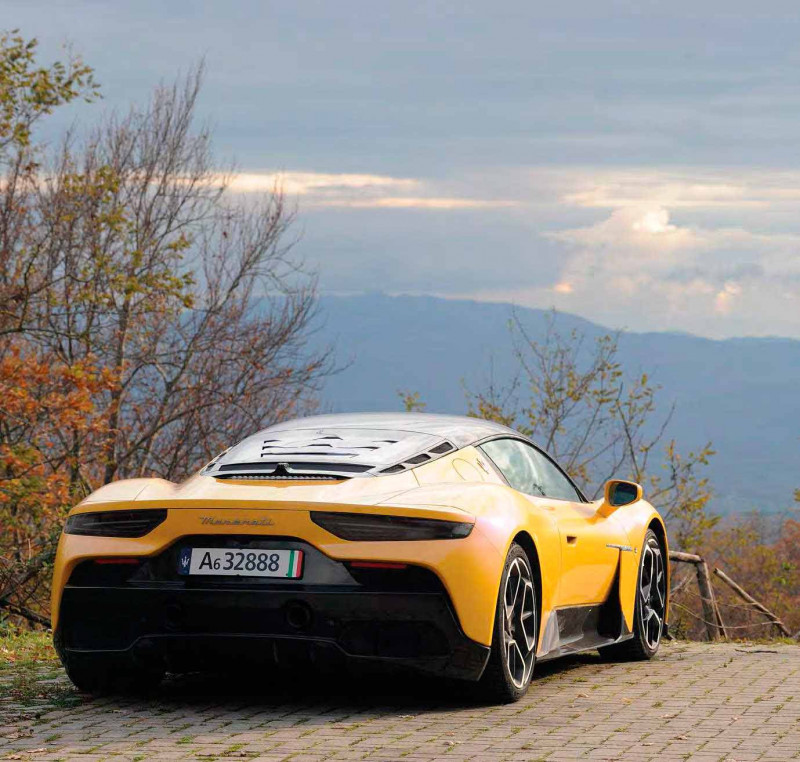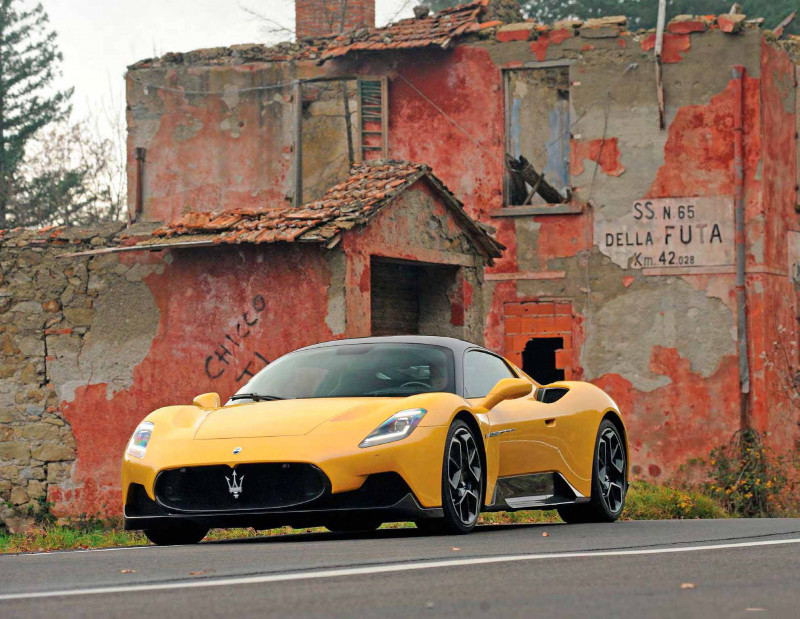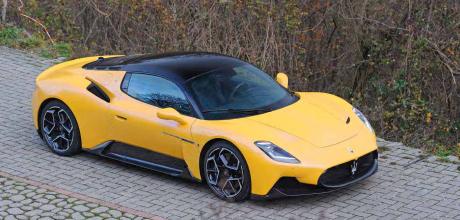2023 Maserati MC20
Mighty MC20 Maserati Tuscan Test. Maserati’s carbon chassis MC20 is one of our most anticipated cars this year. We head into the Tuscan hills to find out whether the all-new Trident pierces the skin of its supercar rivals. Story by Chris Rees. Photography by Michael Ward.
MASERATI MC20
We take the new Trident on a Tuscan test drive
Something is stirring on the fog-swathed plains of Emilia-Romagna: a bright yellow missile seeking out the perfect hot zone to test its firepower. Frankly I could equally well be describing the stirring inside my very being – a feeling that’s been brooding in my blood ever since September 2020, when I went to Modena to witness the unveiling of Maserati’s new MC20. For a car that took so little time to create – an incredible 24 months from blank paper to completion – my wait to drive it has felt almost as long. But finally, my posterior is firmly ensconced in the driver’s seat and I’m heading out of Modena into the Tuscan hills for what has to be the drive of the year.

So why is the MC20 such a big deal? One, because it’s Maserati’s first mid-engined offering since the mighty Ferraribased MC12 of 2004. Then there’s the fact that it has a carbon chassis – again the Trident’s first since the MC12. The MC20 also marks Maserati’s new era in terms of powerplants, with the 630hp twin-turbo Nettuno V6. And can we all agree on this, please: it does look pretty special, doesn’t it? A supercar that’s understated and classically elegant, a Vivaldi opera rapture to the in-yer-face glam-rock posturing of so many rivals.
“This is a supercar that’s understated and classically elegant, a Vivaldi opera to the glam-rock posturing of rivals ”
My heart leaps as I catch sight of ‘our’ yellow MC20 at Maserati’s Via Divisione Acqui HQ – not only because it looks superb in yellow but also because it presents our photographer, Michael, with something bright to work with in low autumn light. The Giallo Genio (‘Genius Yellow) paint has a bluish-yellow hue that really emphasises how this car has been designed in two halves: smooth, organically-shaped, delicate upper bodywork and more technical, muscular, angular lower reaches.

The reason for this approach came from design chief Klaus Busse, who insisted on expunging aerodynamic appendages from the upper half (in stark contrast to most modern supercars), leaving all the aero work to be done ‘down below’. This in turn informed the choice of a carbon chassis. To achieve high front downforce using fixed lower-body aero tech meant incorporating Le Mans-style air channels in the doors, which in turn dictated very thin walls between the cabin and wheel well – which was only achievable with carbon. Just as with the Alfa 4C, Maserati turned to carbonfibre specialist Dallara to co-develop its hand-laid tub. The additional substructures are in lightweight aluminium; interestingly there’s no steel in the car at all, other than a few brackets and screws. The aerodynamics were done in Dallara’s wind tunnel, too, resulting in a Cd figure of 0.38, low for a supercar.
Right, time to get inside. The carbon door rises up, scissor-fashion (a first for Maserati), revealing a cutaway sill that eases entry considerably. Settling into the driver’s seat, with its distinctive black leather and Alcantara ‘blue laser’ pattern, I’m immediately impressed. Without being figure-huggingly tight, it’s comfortable and supportive and there’s a lot of headroom. The sense of quality and design minimalism are immediately apparent. There are just a handful of buttons, most of the controls being sited on the steering wheel, including a launch control button. The carbon dashboard is dominated by two 10-inch screens, one ahead of the driver, the other in the centre. Carbonfibre is on show just about everywhere. Settling in, the driving position is very comfortable, with one exception: your left foot doesn’t have much space, since the wheel well intrudes pretty much right where your foot is. Pressing the engine start button on the steering wheel brings the V6 twin-turbo to life. Contrary to some ill-informed reports, the all-new ‘Nettuno’ V6 – a format chosen for reasons of weight and packaging – has nothing to do with Alfa’s Giulia V6, nor with any Ferrari engine. Instead this is Maserati’s first self-designed power unit since the 3200 GT’s. With only 3.0 litres, it manages to deliver 630hp and 730Nm of torque. It could have been even more, the MC20 Chief Engineer, Gianluca Di Oto, told me: prototypes had to have their torque dialled back to make the car safe and driveable in the real world.

As you’d expect of a car weighing just 1470kg, the performance claims make for eye-popping reading. The top speed of 202mph may be par for the supercar club, as is the 0-62mph time of 2.9 seconds, but what really stands out is the 0-124mph time of 8.8 seconds. In practice, pace is piled on with deceptive and contemptuous ease. I find myself all too easily up to and beyond 100mph – and at that speed it still feels like it’s just getting warmed up. You can thank the two mighty turbochargers for that. So many marques claim to deliver zero turbo lag, but so few actually do; the MC20 is one of those. Well, at least it does as long as you’re spooling above about 2000rpm, while from 3k to 8k, the torque response is not only instantaneous but also absolutely relentless. You almost never need to drop a gear to punch peak acceleration.
Speaking of gears, the MC20 has a dual-clutch eight-speed Tremec automatic transmission. Its programming works very well in all driving modes, of which there are five (Wet, GT, Sport, Corsa and ESC Off, selected via a delicious wheel on the centre console). The gearbox’s capabilities are best experienced in Corsa mode, though, when the cog-swapping is rifle sharp yet super-smooth. Your intimacy with the car is even more intense when you use the paddleshifts to change gear manually.
Next, another crucial test: how does the MC20 sound? As anyone who’s ever owned a Maserati will tell you, the soundtrack is a huge part of the joy of ownership. The V6’s exhaust valves open fully at different points depending on which driving mode you’re in. In GT, they open only above 5000rpm; in Sport it’s 3500rpm; in Corsa it’s all the time. Trouble is, even in Corsa mode, the sound emanating from the engine/exhaust is my biggest disappointment with the MC20. The Alfa Giulia QV – very much from the same stable as the MC20, having been developed by essentially the same people – pops and crackles delightfully on upchanges. Not so the MC20. It’s muted at best, downright dull at worst. OK, let’s shake off the grey-sky blues and head up into the hills to see if we can break through the clouds.
No luck; instead it starts chucking it down and visibility deteriorates. At least that gives me a chance to experience ‘Wet’ driving mode. This being November, local road signs announce that winter tyres are obligatory at these altitudes. Maserati has duly swapped the regular Bridgestone rubber for Michelin Pilot Alpin winter tyres on the triple-pronged wheels. I’m surprised by just how much grip these provide in such awful conditions. In Wet mode the steering is also quite light but it’s never without feel. As for grip and performance in better conditions, we’re going to have to wait a few hours to find some dry roads…
In the meantime, I get a sense of how good the mighty ventilated brakes discs are (380mm x 34mm up front, with Brembo six-pot callipers; 350mm x 27mm at the rear). Larger carbon brakes are optional but I really don’t think they’re necessary – the standard ones perform brilliantly.
Another thing the dismal weather highlights is the peculiar rear view mirror: it’s electronic, transmitting images from a small camera on the engine lid. At first this is unsettling; my eyes take a second to focus and the camera lens is fogging up, impairing the view out. It’s no use switching the mirror to its conventional see-out- the-back position, since the Lexan rear screen is not only letterbox-slim but also obstructed by the engine cooling cut-outs (which are, incidentally, arranged to form a Trident logo when viewed from behind – a nice design touch). Luckily you get accustomed to the camera mirror pretty fast.
So it’s time to find the sun that the paint scheme deserves. Our weather app directs us south towards Firenze via the A1 Panoramica autostrada, where we finally break through the clouds and into glints of autumn sunlight, picking out leaves the same colour as the Maserati. Now at last we have the dry tarmac, the visibility and the right roads to experience what the car can do.
The right roads? Absolutely. Lady luck has delivered us into exactly the right area of the Apennines to climb the Futa Pass, the legendary stretch of the Mille Miglia route close to Mugello Circuit. It’s beloved of bikers because it snakes in a series of tight curves that offer delicious variety: tight switchbacks, undulating straights and sweepingly open esses that invite you to push on as hard as you dare. Rising up from the pretty lakeside at Barberino, the tarmac has just been replaced, presenting the perfect conditions for our test.
I’m starting to push on now, checking the tyre temperature display – cold, OK or hot – and in these cool autumn conditions, we’re reading ‘OK’. The grip is simply astounding. Go into a corner too fast and any hint of understeer is quickly scrubbed off. Of course, with 630hp at your back and call, oversteer is waiting the moment you stab the accelerator hard. In Corsa mode – perfect for these mountain switchbacks, as it doesn’t turn off all assistance features (there’s ESC-Off mode for that) – delightful drifts can be dialled in with sublime progressiveness. Although an electronic diff is an option, our test car sticks with the mechanical limited-slip diff – I must confess, I’d always default to mechanical rather than electronic myself and the MC20 plants its monstrous power with absolute assurance. I have a nagging feeling that I’m driving a supersized Alfa Romeo 4C, a car that – just like the MC20 – counts Maserati’s Modena HQ as its home, and also has a Dallara-developed carbonfibre chassis. There’s an innate sense of handling balance and feel, which must have something to do with Maserati’s choice of identical suspension arms front and rear. But the MC20 succeeds in dialling out all of the 4C’s nervousness, even on surfaces that are far from perfect. The MC20 is superbly well damped and delivers the sort of pliant ride quality that other supercars can only dream of, even on 20-profile tyres.
Yes, the car does bottom out on the bumpiest roads but that comes with the supercar territory. Clear differences in damping can be felt between GT, Sport and Corsa modes, and you can even toggle between damper settings in different modes. Never once did I feel the suspension was anything other than superbly composed. The surprisingly thick-rimmed steering wheel delivers a beautifully linear feel, which is in part down to the ‘semi-virtual’ steering system used both front and rear, developed using experience gained via Alfa’s Giorgio platform.
Some other notes of a practical nature. Luggage capacity is extremely tight: 50 litres up front and 100 in the rear, meaning that Michael’s camera bag doesn’t fit. Another issue is that anything in the rear boot gets baked by the heat-soak from the engine. As for fuel, we managed to average 18mpg during our test drive – not bad for a route that took in mountains, motorways and Modena traffic jams – so the 60-litre tank should give a useful range of around 200 miles. And yes, dear reader, we did have to refuel!
The first customers started receiving their MC20s in September 2021 and production is now running at seven cars per day. Since the MC20 sigil stands for ‘Maserati Corse 2020’, I think we can expect to see Maserati go racing at some stage (and I certainly hope to get one on the track before too long). An open-top MC20 Spider is definitely coming, too, as is an all-electric version with four-wheel drive, more power and more torque, plus – possibly – a hybrid.
VERDICT
Anticipation is a funny thing. High expectations are all too often dashed. And with a car so hotly awaited as the MC20, it perhaps has an impossible task.
Thankfully, I’m delighted to report that it’s a massively impressive machine on almost all of the important fronts. It looks sensational, feels lovely to sit in, offers pulverising pace and has fantastic handling balance. I came away from my drive feeling more relaxed than exhilarated, which is unusual for a supercar. Where the Maserati really scores – pretty much uniquely at this level – is just how comfortable it is. No other supercar rides this well, feels so refined or is as easy to pilot. The one big disappointment is that the soundtrack lacks a certain zing, but I guess if that’s what you really want, Lamborghini is there to take your money.
Compared to its rivals – the closest being the McLaren Artura and Lamborghini Huracán, the Ferrari F8 Tributo being quite a lot pricier with the inevitable options added – the MC20 feels more mature, easier to live with and more comfortable. Overall, I came away thinking the MC20 makes the ideal daily supercar and – probably – the best sub-£200k mid-engined all-rounder there is.
TECHNICAL SPECIFICATIONS 2023 Maserati MC20
- ENGINE: 3000cc V6 twin-turbo
- BORE X STROKE: 88mm x 82mm
- COMPRESSION RATIO: 11:1
- MAX POWER: 630bhp at 7500rpm
- MAX TORQUE: 730Nm at 3000rpm
- TRANSMISSION: 8-speed DCT automatic
- TYRES: 245/35 ZR20 front, 305/30 ZR20 rear
- DIMENSIONS: 4669mm (L), 1965mm (W), 1224mm (H)
- KERB WEIGHT: 1470kg
- FUEL CONSUMPTION: 24.4mpg
- CO2 EMMISIONS: 262g/km
- MAX SPEED: 202mph
- 0-62MPH: 2.9 sec
- PRICE: £187,230
Handling balance is sweet and delicate, ride quality is a revelation. Sheer pace on offer is enormous, although soundtrack is muted.



RESISTANCE IS FUTA
Just reading the latest issue and your MC20 test to improve my mood prior to a trip to the dentist, I saw that you drove over the Futa Pass which was part of the old Mugello road circuit. I only realised this after researching the close-by town of Fiesole, east of Prato, outside which is the castle of Vincigliata, used as Mussolini's ‘Colditz’.